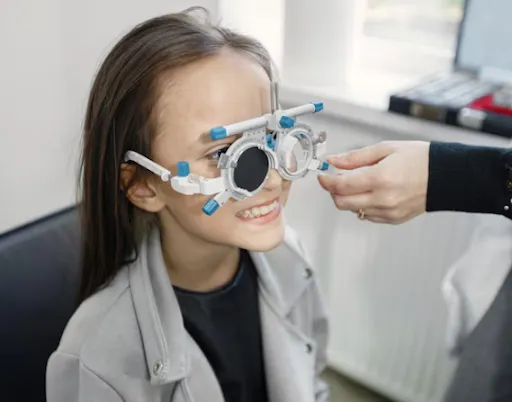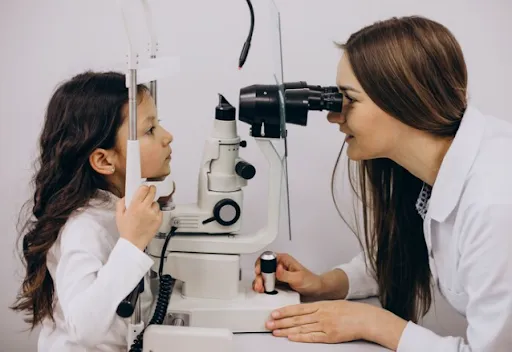Color Vision Basics
Understanding Color Vision Deficiency
FSDAVCFEBFEVSDDVFSD
FSDAVCFEBFEVSDDVFSD
FSDAVCFEBFEVSDDVFSD
Causes of Color Vision Deficiency
Color vision deficiency, commonly known as color blindness, is primarily caused by genetic factors. This condition is typically inherited and results from anomalies in the color-detecting pigments in the retina. Most cases of color vision deficiency are inherited, but it can also occur due to certain medical conditions or medications. Learn more about the genetic factors related to eye health.
Acquired color vision deficiency can develop due to diseases such as diabetes or multiple sclerosis. Additionally, some medications and eye injuries can lead to a loss of color perception. Find out more about managing chronic conditions that may affect vision.
Color vision deficiency, commonly known as color blindness, is primarily caused by genetic factors. This condition is typically inherited and results from anomalies in the color-detecting pigments in the retina. Most cases of color vision deficiency are inherited, but it can also occur due to certain medical conditions or medications. Learn more about the genetic factors related to eye health.

Acquired color vision deficiency can develop due to diseases such as diabetes or multiple sclerosis. Additionally, some medications and eye injuries can lead to a loss of color perception. Find out more about managing chronic conditions that may affect vision.

Types of Color Vision Deficiency
The most prevalent forms are red-green color deficiency, which impairs the ability to distinguish between red and green hues, and blue-yellow color deficiency, impacting the differentiation between blue and yellow colors. Rarely, individuals may experience total color blindness, a condition where no colors are perceived at all. This significant alteration in color perception can affect daily activities and interactions. Explore the various types of color vision deficiencies and tests in detail to learn more about these conditions.
The underlying causes of these deficiencies vary. Red-green deficiencies often result from genetic mutations on the X chromosome, which disrupt the function of cones responsible for detecting these colors. In contrast, blue-yellow deficiencies are typically due to problems with the retina’s cone cells, which are crucial for blue and yellow color perception. Additionally, some color vision deficiencies can be acquired due to diseases or injuries affecting the eyes or brain. Read about the latest research on color vision to stay informed about advancements and treatments.
Understanding these types is essential for managing and adapting to color vision deficiencies. Each type requires specific strategies for coping and support. Learn more about managing color vision deficiencies to discover tailored solutions.
Diagnosing Color Vision Problems

Diagnosing color vision deficiency involves tests by an eye care professional, such as the Ishihara test, which uses color plates to identify the type and extent of color blindness. The Farnsworth-Munsell 100 Hue Test provides a detailed assessment of color discrimination. Schedule a vision test to check for color vision deficiency.
Regular eye exams are crucial, especially if you struggle with color distinction. Understand the importance of routine eye care to maintain overall eye health. Regular eye exams are crucial, especially if you experience difficulties distinguishing colors. Color vision deficiencies can sometimes indicate underlying health issues or changes in eye health that need attention. Regular eye exams are crucial, especially if you experience difficulties distinguishing colors. Color vision deficiencies can sometimes indicate underlying health issues or changes in eye health that need attention.

Regular check-ups with an eye care professional ensure that any potential problems are identified early and managed appropriately. Additionally, eye exams provide an opportunity to update prescriptions and check for other conditions that could impact your vision. Understand the importance of routine eye care to keep your eyes healthy and functioning well.
Early diagnosis of color vision deficiency can help in effectively managing the condition and developing strategies to cope with daily challenges. Identifying color vision issues early allows for timely intervention and adjustment of lifestyle or work environments to better accommodate the condition. Proactive management can significantly improve quality of life and reduce the impact of color vision deficiencies on daily activities. Regular eye exams are essential to staying ahead of potential issues and maintaining overall eye health.
Managing Color Vision Deficiency
While there is no cure for color vision deficiency, several strategies can help manage the condition effectively. Specialized glasses and contact lenses are designed to filter specific wavelengths of light, which can enhance color perception and make daily activities easier. These aids are particularly useful for distinguishing between colors that may otherwise appear similar. Discover how color vision aids can help improve your color perception and adapt to daily challenges.
In addition, educational tools and apps tailored for color vision deficiency provide valuable features for color identification and differentiation. These resources can assist with tasks such as selecting clothing or interpreting color-coded information, making everyday activities more manageable. Explore resources for color vision tools to find solutions that suit your needs and help you navigate color-related tasks with greater ease.
Daily Life Adjustments
Adapting to color vision deficiency involves practical adjustments in daily life. For example, using labels or organizing items by shape rather than color can make tasks easier. Implementing color-coded systems with distinct patterns helps in distinguishing between items more effectively. Learn about practical tips for color vision management to enhance daily living.
In professional settings, it's important to communicate your color vision needs to colleagues to avoid misunderstandings. Utilizing technology and tools specifically designed for color vision deficiency can assist in tasks that require color differentiation. Read about workplace accommodations to create a supportive work environment and ensure that your color vision challenges are managed effectively.
Adapting to color vision deficiency involves practical adjustments in daily life. For example, using labels or organizing items by shape rather than color can make tasks easier. Implementing color-coded systems with distinct patterns helps in distinguishing between items more effectively. Learn about practical tips for color vision management to enhance daily living.

In professional settings, it's important to communicate your color vision needs to colleagues to avoid misunderstandings. Utilizing technology and tools specifically designed for color vision deficiency can assist in tasks that require color differentiation. Read about workplace accommodations to create a supportive work environment and ensure that your color vision challenges are managed effectively.

Future Developments in Color Vision Research
Ongoing research in the field of color vision deficiency is making significant strides, focusing on potential treatments and technological advancements. One promising area of study is gene therapy, which aims to correct the genetic mutations responsible for color vision deficiencies. Researchers are also exploring retinal implants that could restore color perception by replacing damaged retinal cells with electronic devices. Although these treatments are still in the experimental stages, they offer hope for future breakthroughs. Stay updated on advancements in eye research to learn about the latest developments in this exciting field.
In addition to groundbreaking treatments, innovation in assistive technologies is improving the quality of life for individuals with color vision deficiencies. New tools and devices designed to aid color differentiation, such as advanced color filters and augmented reality applications, are becoming increasingly available. These technologies help individuals manage their condition more effectively and navigate daily tasks with greater ease. Follow the latest updates in vision technology to stay informed about these advancements and how they can benefit you.
Furthermore, diagnostic tools are also advancing, providing more accurate and detailed assessments of color vision deficiencies. Enhanced testing methods can lead to better understanding and management of the condition. As research and technology continue to evolve, individuals with color vision deficiencies can expect improved solutions and support. Keeping abreast of these developments will help in adapting to new methods and making the most of available resources. Read about the latest research on color vision to stay informed about emerging trends and innovations.
Support and Resources
Several organizations and support groups offer resources for individuals with color vision deficiency. These groups provide information, support, and advocacy to help individuals navigate their condition and find suitable solutions. Engaging with these communities can offer valuable assistance and connect individuals with others who share similar experiences.
Find support groups and resources for color vision deficiency.

Several organizations and support groups offer resources for individuals with color vision deficiency. These groups provide information, support, and advocacy to help individuals navigate their condition and find suitable solutions. Engaging with these communities can offer valuable assistance and connect individuals with others who share similar experiences. Find support groups and resources for color vision deficiency.
Additionally, educational resources such as books and online courses can help individuals understand more about their condition and learn effective management strategies. These materials offer a wealth of information on coping techniques, daily living aids, and advancements in treatment options. By engaging with these resources, individuals can better navigate their condition and improve their quality of life. Moreover, sharing personal experiences through these platforms can inspire others and foster a sense of community.
Additionally, educational resources such as books and online courses can help individuals understand more about their condition and learn effective management strategies. These materials offer a wealth of information on coping techniques, daily living aids, and advancements in treatment options. By engaging with these resources, individuals can better navigate their condition and improve their quality of life. Moreover, sharing personal experiences through these platforms can inspire others and foster a sense of community.
Conclusion and Next Steps
Understanding color vision deficiency involves recognizing its causes, types, and management strategies. While there is no cure, various aids and adjustments can significantly improve daily life. Regular eye exams and staying informed about new research are essential for effectively managing the condition. By understanding the nature of color vision deficiency and utilizing available tools, individuals can navigate challenges and enhance their quality of life. For personalized support and to explore management options, visit our eye care services.
Incorporating these strategies and resources can greatly enhance an individual's ability to cope with and manage color vision deficiency. Whether through specialized aids, lifestyle adjustments, or staying up-to-date with research, these steps can make a meaningful difference in everyday experiences. For further assistance and tailored advice, visit our eye care services for comprehensive support and information.

Contact Info
Hours of Operation
Mon - Fri | 9:00 AM - 5:00 PM
Sat - Sun | Closed
Holiday Hours: We are closed for the following holidays: New Years Day, Memorial Day, Independence Day, Labor Day, Thanksgiving Day, Christmas Day
© 2025 Kleinwood Vision. All rights Reserved.


